
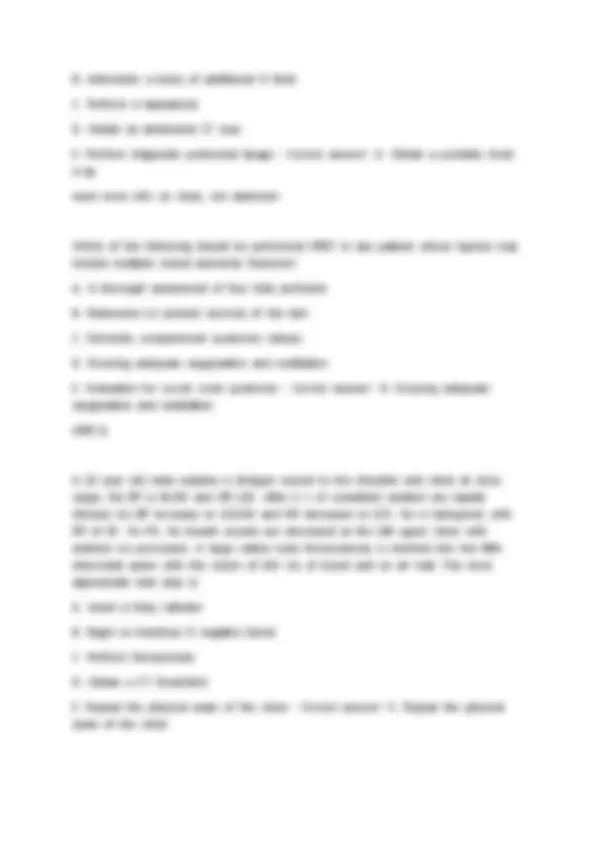
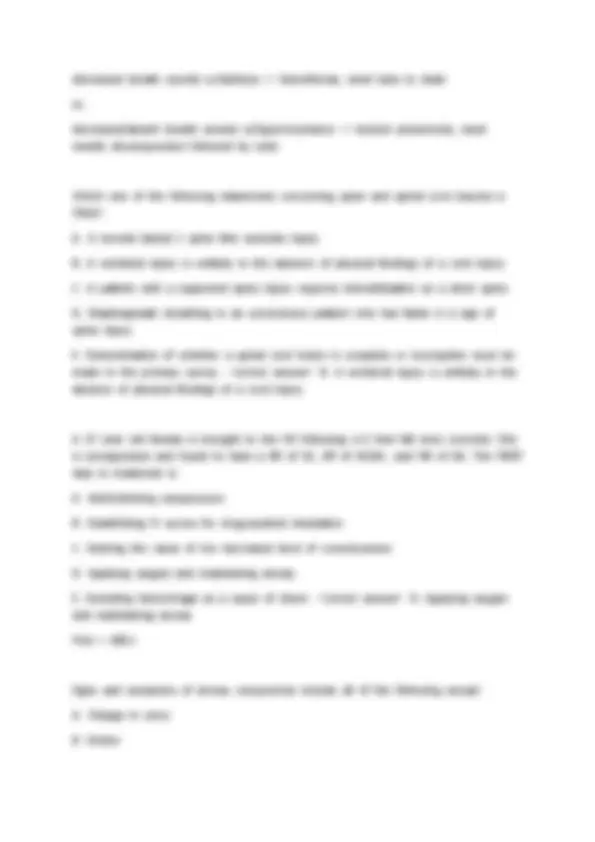
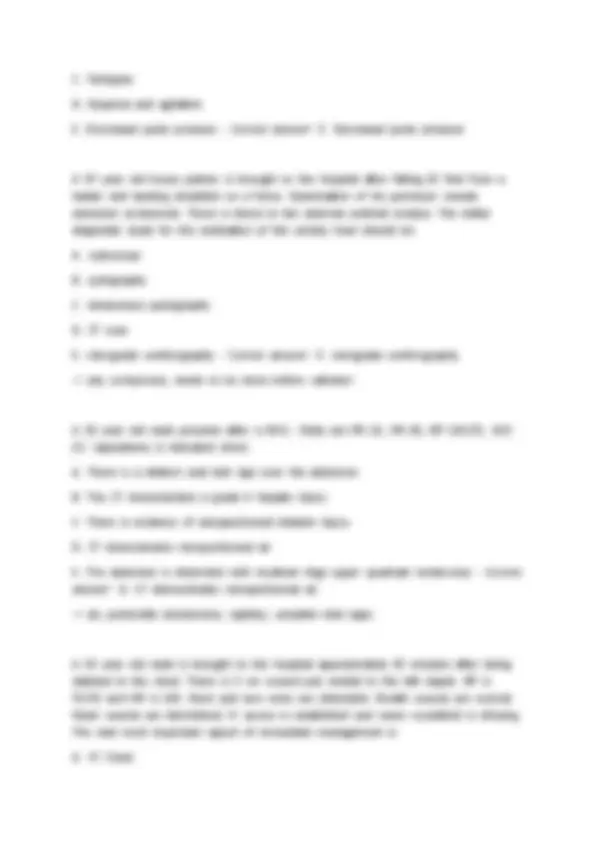
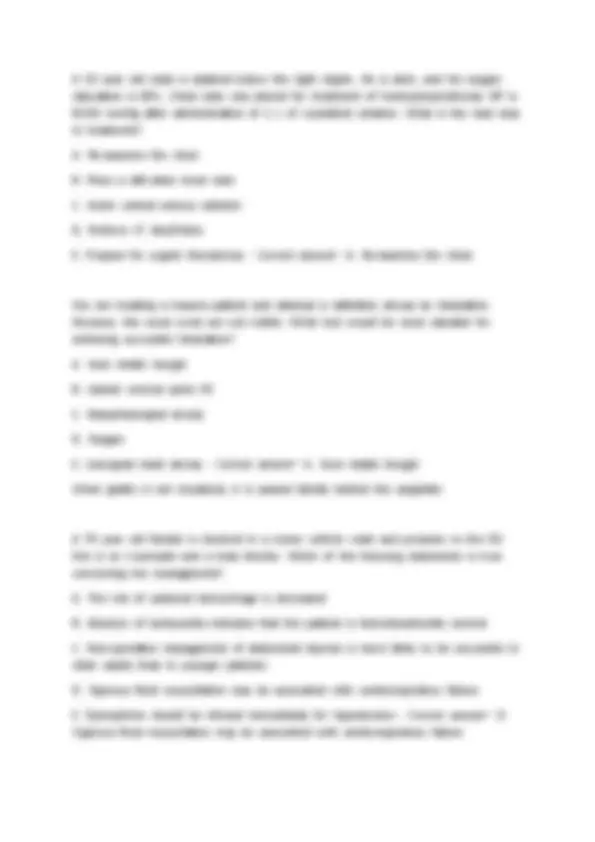
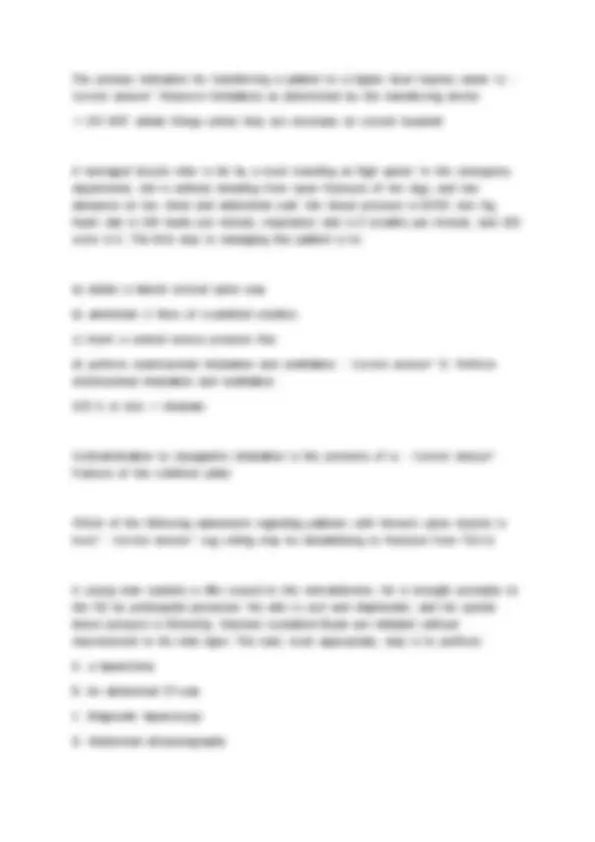
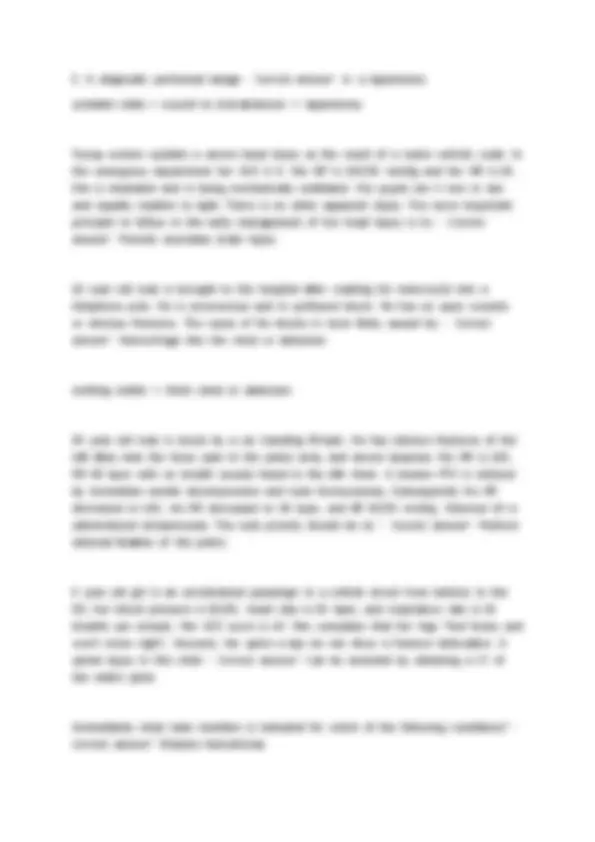
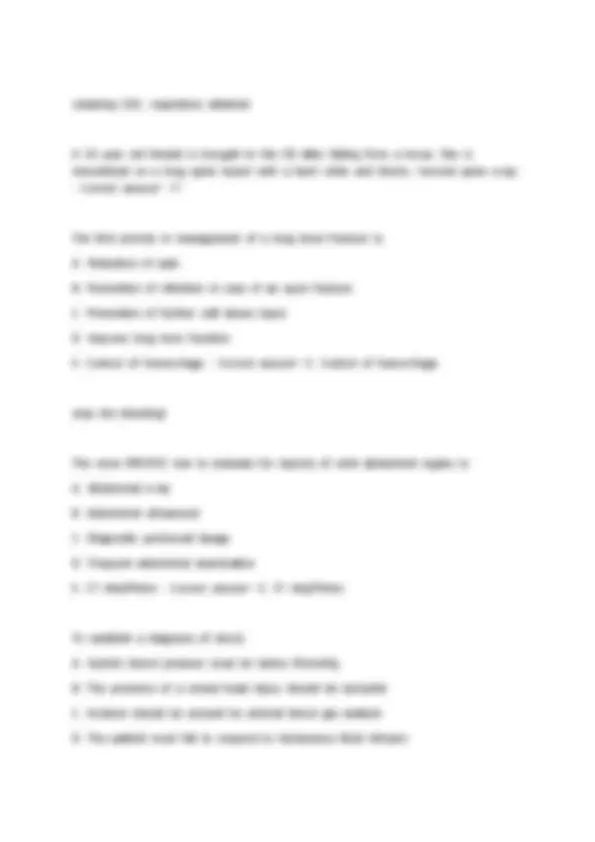
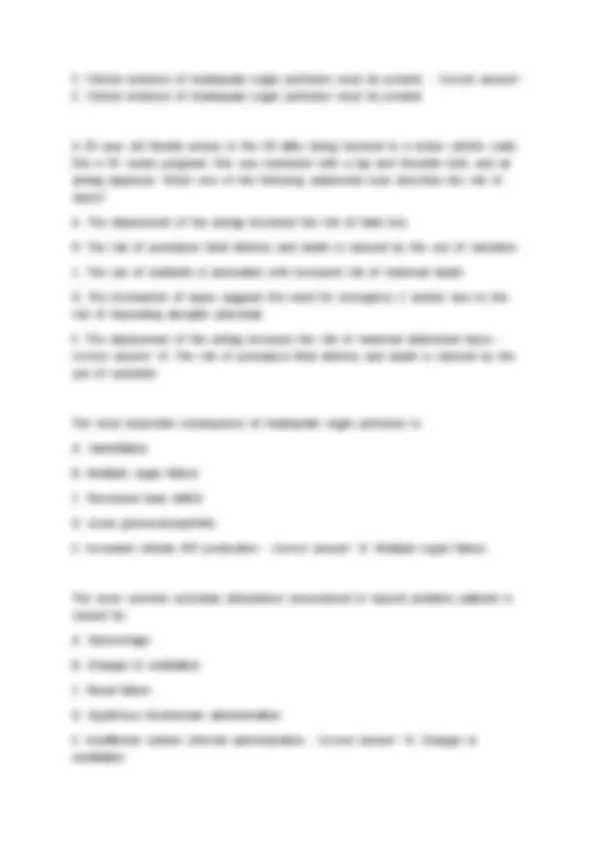
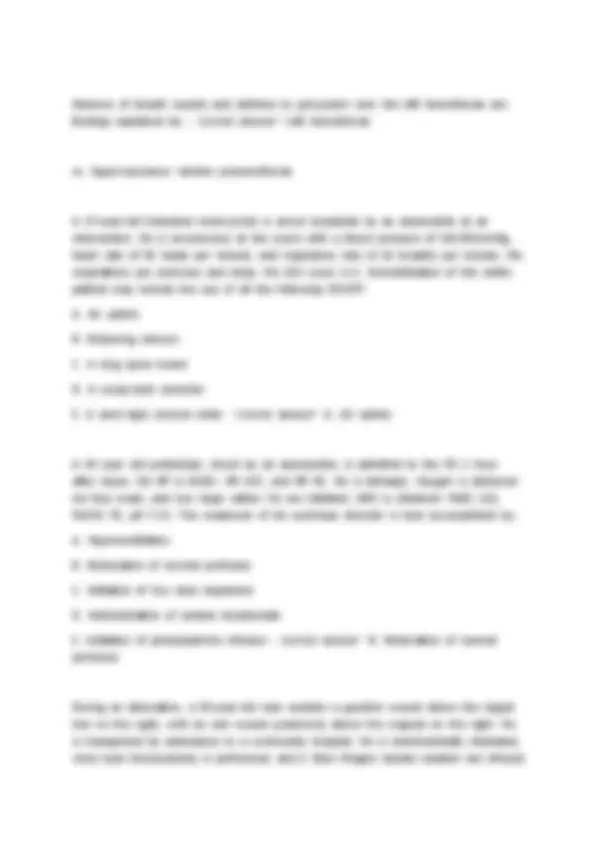
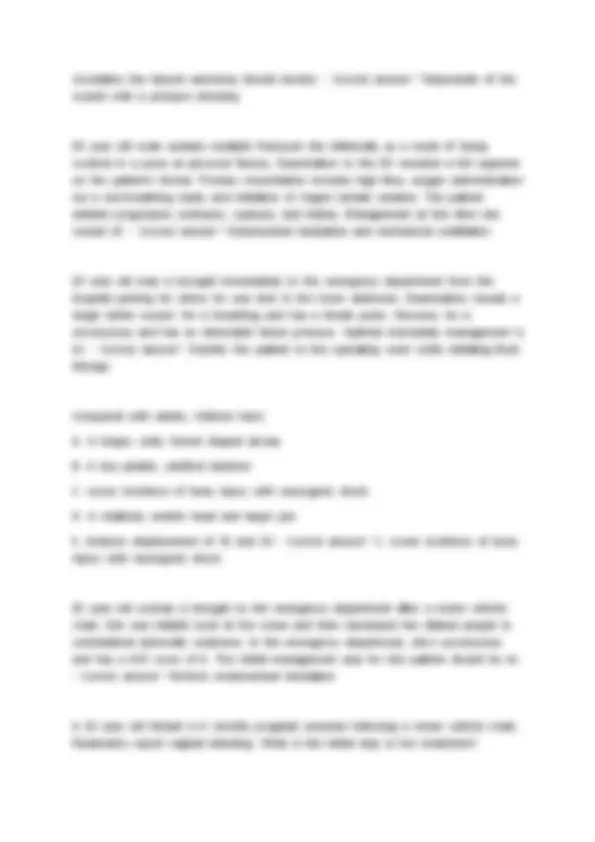
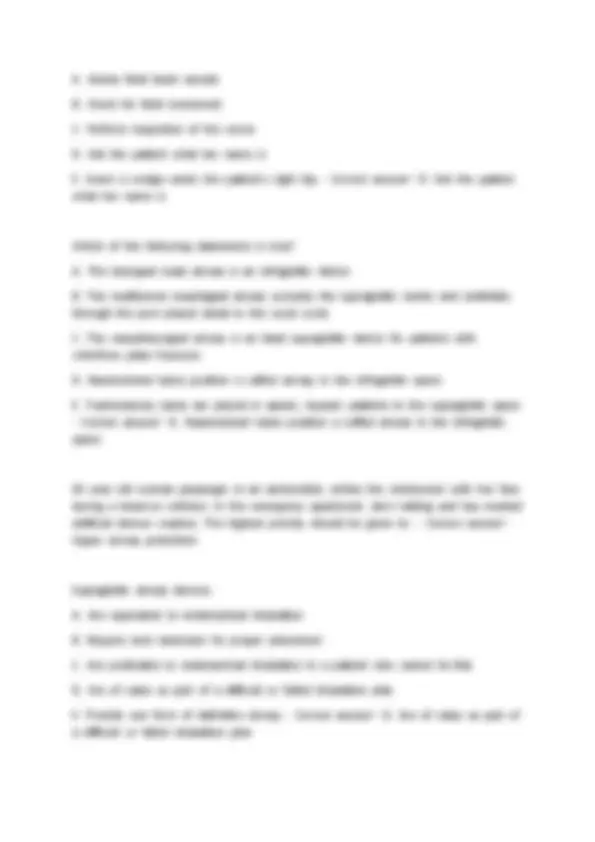
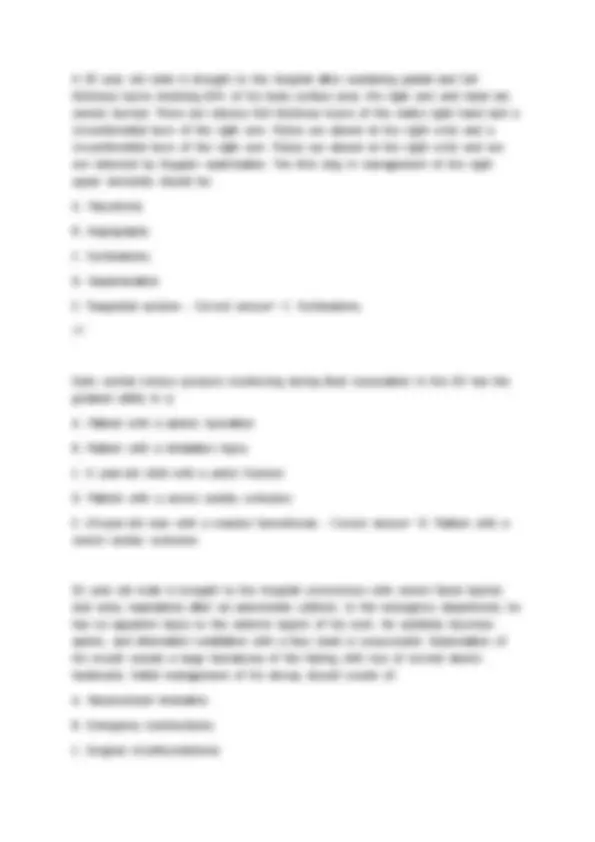
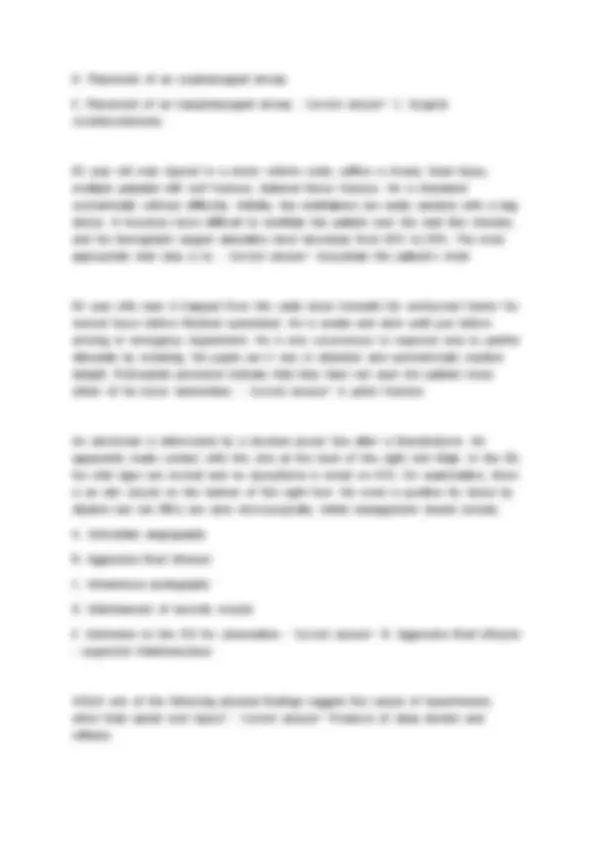
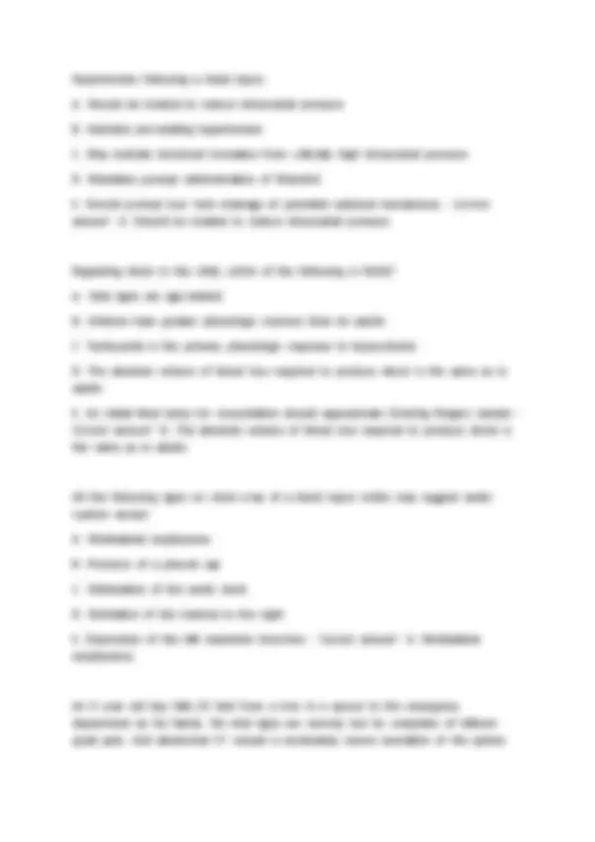
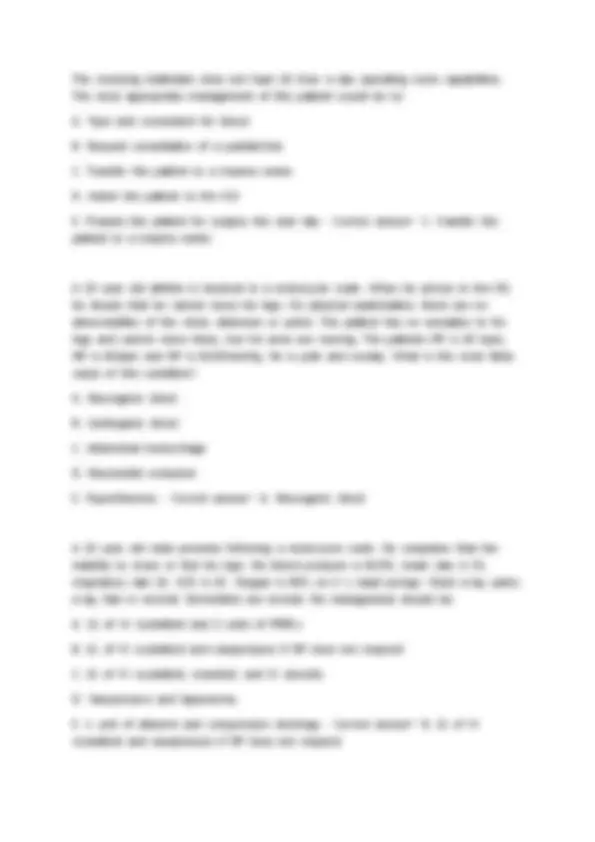
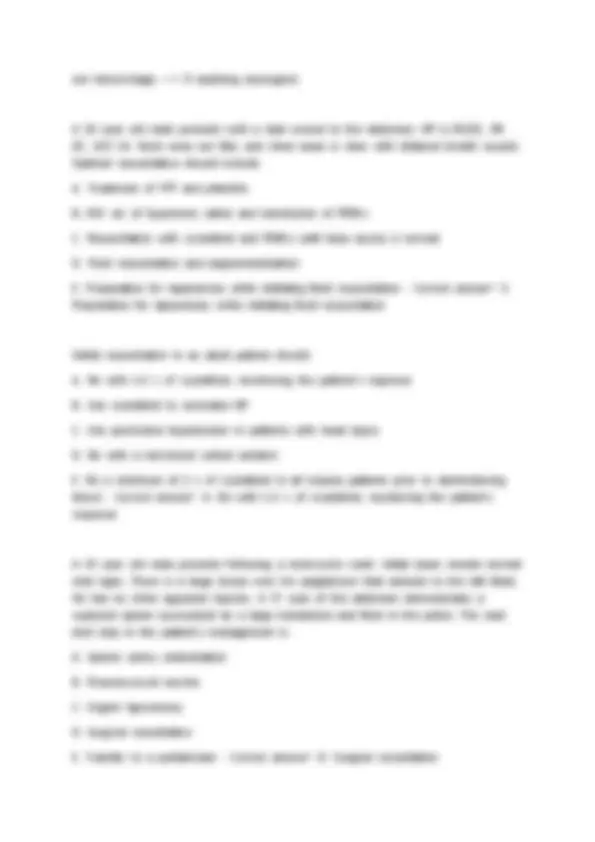
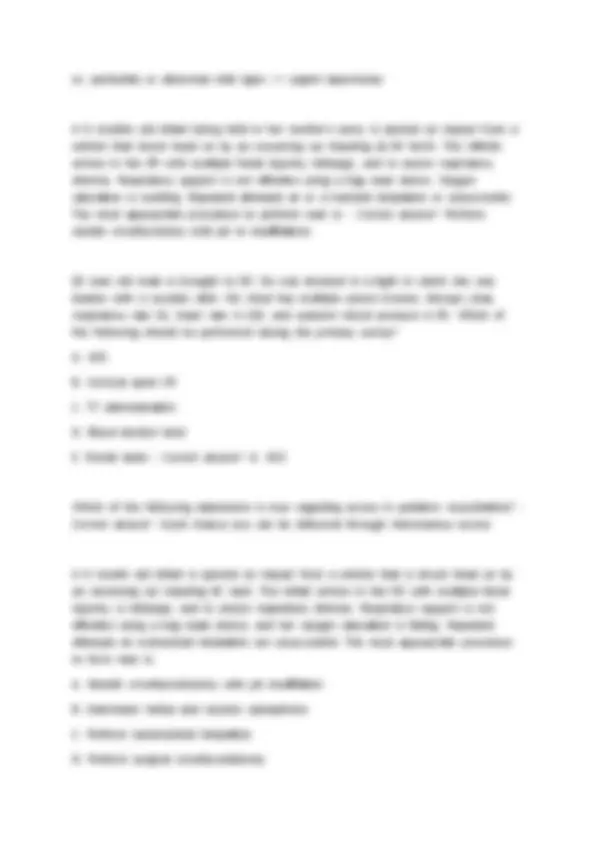
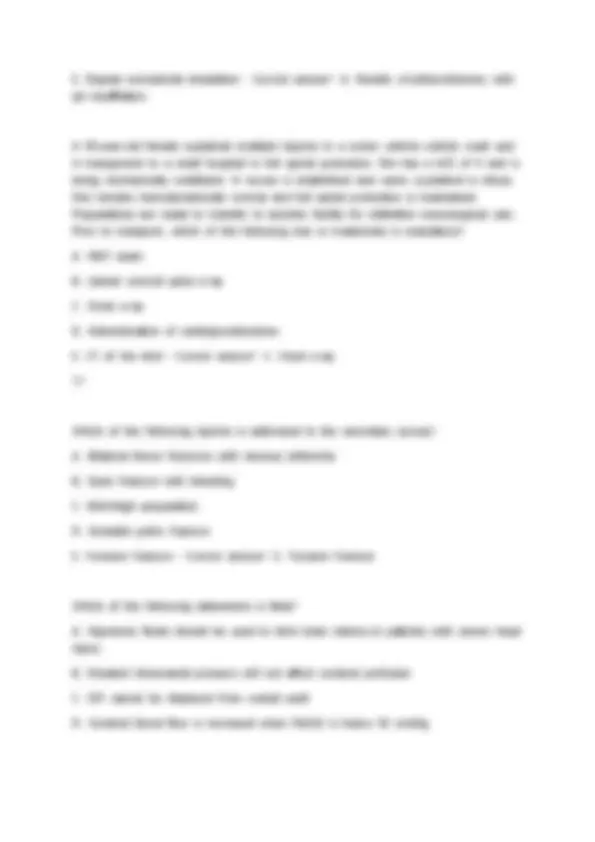
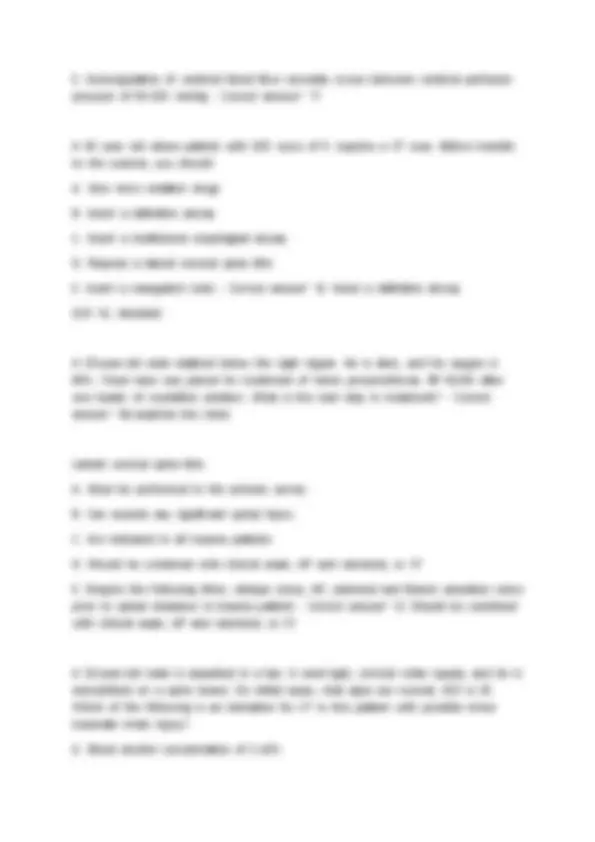
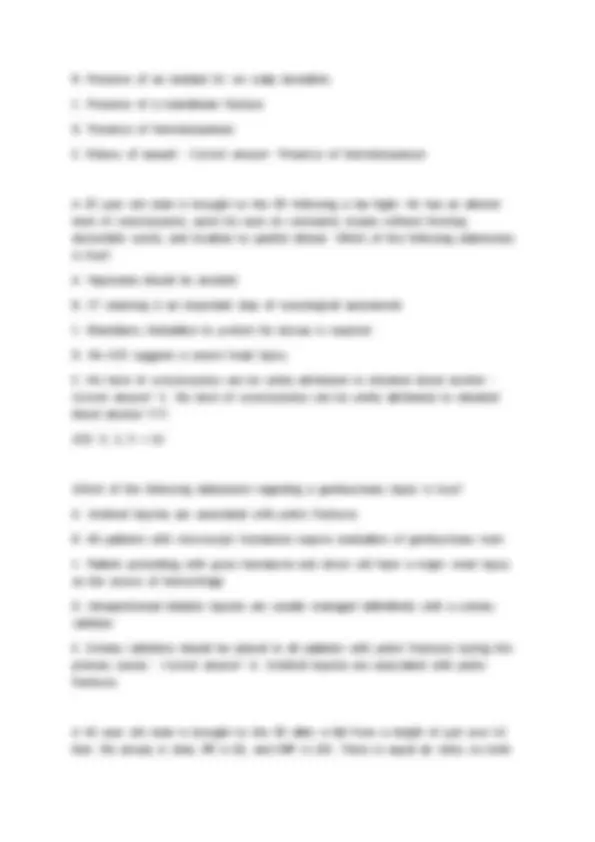
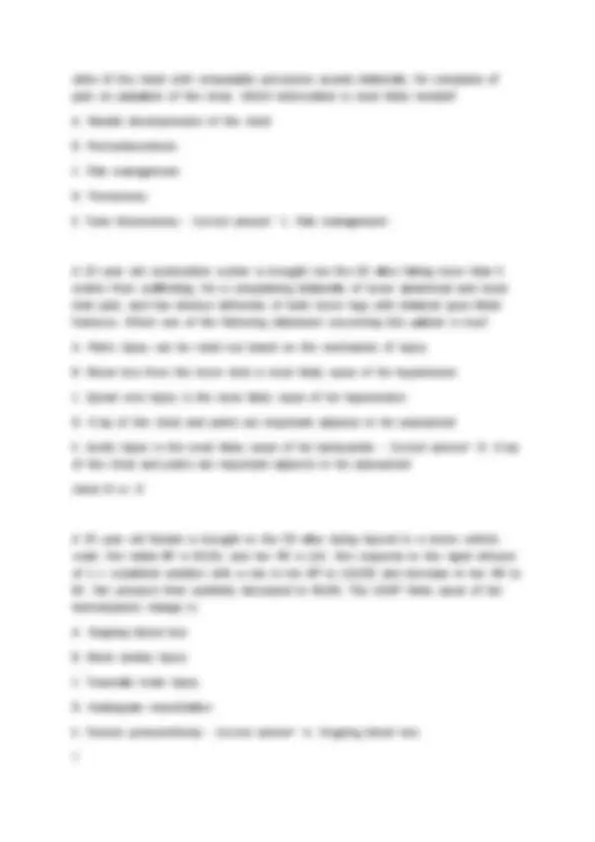
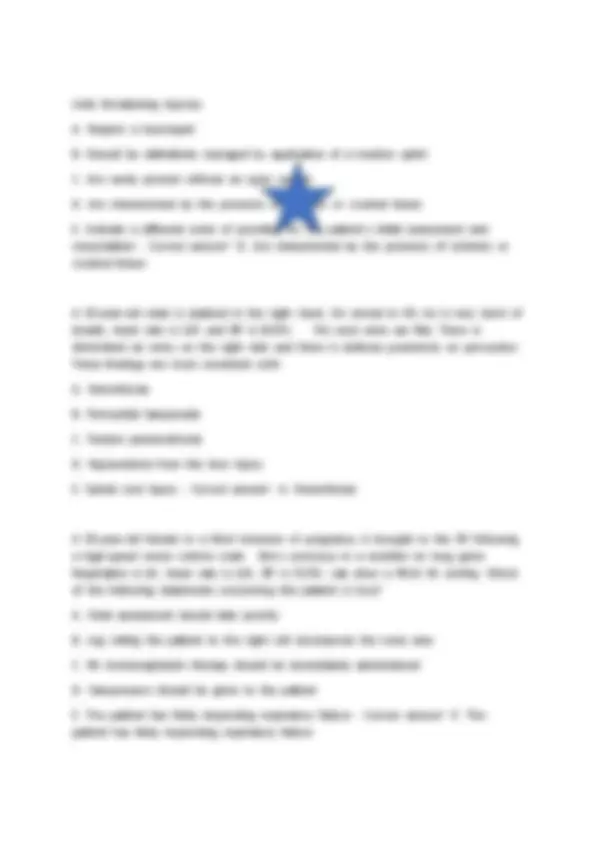
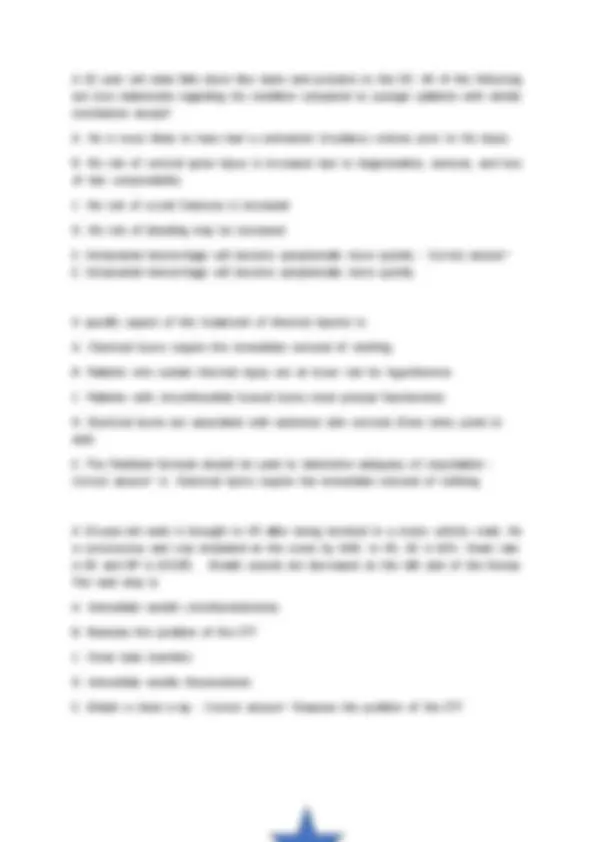


Study with the several resources on Docsity

Earn points by helping other students or get them with a premium plan


Prepare for your exams
Study with the several resources on Docsity

Earn points to download
Earn points by helping other students or get them with a premium plan
Community
Ask the community for help and clear up your study doubts
Discover the best universities in your country according to Docsity users
Free resources
Download our free guides on studying techniques, anxiety management strategies, and thesis advice from Docsity tutors
ATLS POST TEST QUESTIONS AND ANSWERS 2025.pdf
Typology: Exams
1 / 31

This page cannot be seen from the preview
Don't miss anything!
























A 22 year old male is brought by ambulance to a small community hospital after falling from the top of an 8 foot ladder. Initially, he was found to have a large right pneumothorax. A chest tube was inserted and connected to an underwater seal drainage collection system with negative pressure. A repeat CXR demonstrates a residual, large right pneumothorax. After transferring the patient to a verified trauma center, a third chest x-ray reveals a persistent right pneumothorax. The chest tube appears to be functioning and in good position. He remains hemodynamically normal with no signs of respiratory distress. The most likely cause for the persistent right pneumothorax is: A. Flail chest B. Diaphragmatic injury C. Pulmonary contusion D. Esophageal perforation E. Tracheobronchial injury - Correct answer~ E. Tracheobronchial injury Which of the following is LEAST reliable for diagnosing ESOPHAGEAL intubation? A. symmetrical chest wall movement B. end-tidal CO C. bilateral breath sounds D. oxygen saturation >92% E. ETT above carina on chest x-ray - Correct answer~ D. oxygen saturation >92%
if it says ESOPHAGEAL, go with this answer Which of the following signs necessitates the need for a definitive airway in severe trauma patient? A. facial lacerations
B. repeated vomiting C. severe maxillofacial trauma D. sternal fracture E. GCS 12 - Correct answer~ C. Severe maxillofacial trauma Twenty seven people are severely injured in an aircraft crash at a local airport. The principles of triage include: A. establish a triage site within the internal perimeter of the crash site B. treat only the most severely injured patients first C. immediately transport all patients to the nearest hospital D. treat the greatest number of patients in the shortest period of time E. produce the greatest number of survivors based on available resources - Correct answer~ E. Produce the greatest number of survivors based on available resources Which of the following statements are correct? A. Cerebral contusions may coalesce to form an intracerebral hematoma B. Epidural hematomas are usually seen in the frontal region C. Subdural hematomas are caused by injury to the middle meningeal artery D. Subdural hematomas typically have a lenticular shape on CT E. The associated brain damage is more severe in epidural hematomas - Correct answer~ A. Cerebral contusions may coalesce to form an intracerebral hematoma EM: Epidural, middle meningeal SuB: Subdural, Bridging veins An 18 year old male is brought to the ED after being shot. He has one bullet wound just below the right clavicle and another just below the costal margin in the right posterior axillary line. His blood pressure is 110/60, heart rate of 90, and respiratory rate of 34. After ensuring a patent airway and inserting 2 large caliber IV lines, the next most appropriate step is to: A. Obtain a portable chest x-ray
decreased breath sounds w/dullness - > hemothorax, need tube to drain vs. decreased/absent breath sounds w/hyperresonance - > tension pneumonia, need needle decompression followed by tube Which one of the following statements concerning spine and spinal cord trauma is TRUE? A. A normal lateral C spine film excludes injury B. A vertebral injury is unlikely in the absence of physical findings of a cord injury C. A patient with a suspected spine injury requires immobilization on a short spine D. Diaphragmatic breathing in an unconscious patient who has fallen is a sign of spine injury E. Determination of whether a spinal cord lesion is complete or incomplete must be made in the primary survey - Correct answer~ B. A vertebral injury is unlikely in the absence of physical findings of a cord injury A 17 year old female is brought to the ED following a 6 feet fall onto concrete. She is unresponsive and found to have a RR of 32, BP of 90/60, and HR of 68. The FIRST step in treatment is: A. Administering vasopressors B. Establishing IV access for drug-assisted intubation C. Seeking the cause of her decreased level of consciousness D. Applying oxygen and maintaining airway E. Excluding hemorrhage as a cause of shock - Correct answer~ D. Applying oxygen and maintaining airway First = ABCs Signs and symptoms of airway compromise include all of the following except: A. Change in voice B. Stridor
C. Tachypea D. Dyspnea and agitation E. Decreased pulse pressure - Correct answer~ E. Decreased pulse pressure A 47 year old house painter is brought to the hospital after falling 20 feet from a ladder and landing straddled on a fence. Examination of his perineum reveals extensive ecchymosis. There is blood in the external urethral meatus. The initial diagnostic study for the evaluation of the urinary tract should be: A. cystoscopy B. cystography C. intravenous pyelography D. CT scan E. retrograde urethrography - Correct answer~ E. retrograde urethrography
any ecchymosis, needs to be done before catheter! A 30 year old male presents after a MVC. Vitals are RR 18, HR 88, BP 130/72, GCS
air, peritonitis (tenderness, rigidity), unstable vital signs A 20 year old male is brought to the hospital approximately 30 minutes after being stabbed in the chest. There is 3 cm wound just medial to the left nipple. BP is 70/33 and HR is 140. Neck and arm veins are distended. Breath sounds are normal. Heart sounds are diminished, IV access is established and warm crystalloid is infusing. The next most important aspect of immediate management is: A. CT Chest
Which of the following is true regarding a PREGNANT patient who presents following blunt trauma? A. Early gastric decompression is important B. A hemoglobin level of 10 indicates recent blood loss C. The CVP response to volume resuscitation is blunted in pregnant patients D. A lap belt is the best form of restraint due to the size of the gravid uterus E. A PaCO2 of 40 provides reassurance about the adequancy of respiratory function - Correct answer~ A. Early gastric decompression is important Which one of the following statements is FALSE concerning Rh isoimmunization in pregnant trauma patients? A. It occurs in blunt or penetrating abdominal trauma B. It is produced by minor degrees of fetomaternal hemorrhage C. Rh immunoglobulin therapy should be administered to pregnant females who have sustained a gunshot wound to the leg D. This is not a problem in traumatized, Rh-positive pregnant patients E. Initiation of Rh immunoglobulin therapy does not require proof of fetomaternal hemorrhage - Correct answer~ C. Rh immunoglobulin therapy should be administered to pregnant females who have sustained a gunshot wound to the leg Which of the following statements is TRUE regarding access in pediatric resuscitation? A. Intraosseous access should be only be considered after 5 percutaneous attempts B. Cut down at the ankle is a preferred initial access technique C. Blood transfusion can be delivered through intraosseous access D. Internal jugular cannulation is the next preferred option when percutaneous venous access fails E. Intraosseous cannulation should be first choice for access - Correct answer~ C. Blood transfusion can be delivered through intraosseous access (anything can be delievered IO)
A 23 year old male is stabbed below the right nipple. He is alert, and his oxygen saturation is 98%. Chest tube was placed for treatment of hemopneumothorax. BP is 90/60 mmHg after administration of 1 L of crystalloid solution. What is the next step in treatment? A. Re-examine the chest B. Place a left-sided chest tube C. Insert central venous catheter D. Perform CT Abd/Pelvis E. Prepare for urgent thoractomy - Correct answer~ A. Re-examine the chest You are treating a trauma patient and attempt a definitive airway by intubation. However, the vocal cords are not visible. What tool would be most valuable for achieving successful intubation? A. Gum elastic bougie B. Lateral cervical spine XR C. Nasopharyngeal airway D. Oxygen E. Laryngeal mask airway - Correct answer~ A. Gum elastic bougie When glottis is not visualized, it is passed blindly behind the epiglottis A 79 year old female is involved in a motor vehicle crash and presents to the ED. She is on Coumadin and a beta blocker. Which of the folowing statements is true concerning her management? A. The risk of subdural hemorrhage is decreased B. Absence of tachycardia indicates that the patient is hemodynamically normal C. Non-operative management of abdominal injuries is more likely to be successful in older adults than in younger patients D. Vigorous fluid resuscitation may be assocaited with cardiorespiratory failure E. Epinephrine should be infused immediately for hypotension - Correct answer~ D. Vigorous fluid resuscitation may be assocaited with cardiorespiratory failure
E. A diagnostic peritoneal lavage - Correct answer~ A. a laparotomy unstable vitals + wound to mid-abdomen - > laparotomy Young women sustains a severe head injury as the result of a motor vehicle crash. In the emergency department her GCS is 6. Her BP is 140/90 mmHg and her HR is 80. She is intubated and is being mechanically ventilated. Her pupils are 3 mm in size and equally reactive to light. There is no other apparent injury. The more important principle to follow in the early management of her head injury is to: - Correct answer~ Prevent secondary brain injury 22 year old man is brought to the hospital after crashing his motorcycle into a telephone pole. He is unconscious and in profound shock. He has no open wounds or obvious fractures. The cause of his shocks is most likely caused by: - Correct answer~ Hemorrhage into the chest or abdomen nothing visible - > think chest or abdomen 30 year old man is struck by a car traveling 35mph. He has obvious fractures of the left tibia near the knee, pain in the pelvis area, and severe dyspnea. His HR is 180, RR 48 bpm with no breath sounds heard in the left chest. A tension PTX is relieved by immediate needle decompression and tube thoracostomy. Subsequently his HR decreased to 140, his RR decreased to 36 bpm, and BP 80/50 mmHg. Warmed LR is administered intravenously. The next priority should be to: - Correct answer~ Perform external fixation of the pelvis 8 year old girl is an unrestrained passenger in a vehicle struck from behind. In the ED, her blood pressure is 80/60, heart rate is 80 bpm, and respiratory rate is 16 breaths per minute. Her GCS score is 14. She complains that her legs "feel funny and won't move right", however, her spine x-rays do not show a fracture dislocation. A spinal injury in this child: - Correct answer~ Can be excluded by obtaining a CT of the entire spine Immediately chest tube insertion is indicated for which of the following conditions? - Correct answer~ Massive hemothorax
18 year old helmeted motorcyclist is brought by ambulance to the emergency department following a high speed crash. Pre-hospital personnel report that he was thrown 50 feet off his bike. He has a history of hypotension prior to arrival in the ED, but is now awake, alert, and conversational. Which of the following statements is true? - Correct answer~ The patient probably has an acute epidural hematoma (lucid interval) Crosstable, lateral XR of the cervical spine: - Correct answer~ Is unacceptable unless 7 cervical vertebra and the C7 to T1 relationship are visualized A 30 year old woman fell down four stairs landing on concrete. Witnesses report she was unconscious for five minutes beginning immediately after the fall. She regained full consciousness during the 10 minute transport to the hospital. Upon arrival to the ED, she is awake, alert, and responsive with a GCS of 15. Her only complaint is a slight headache. Thirty minutes later, she becomes unresponsive with a GCS of 6. On exam, her left pupil is large and nonreactive. The right pupil is normal. This is most consistent with: A. Subdural hematoma B. Epidural hematoma C. Occipital lobe hemorrhage D. Focal subarachnoid hemorrhage E. Cerebellar hemorrhage - Correct answer~ B. Epidural hematoma (lucid interval) During resuscitation, which one of the following is the most reliable as a guide to volume replacement? - Correct answer~ Urinary output Adults: 0.5 cc/kg Kids 1 cc/kg Which one of the following is the recommended method for initially treating frostbite?
retaining CO2, respiratory alkalosis A 14 year old female is brought to the ED after falling from a horse. She is immoblized on a long spine board with a hard collar and blocks. Cervical spine x-ray:
E. Clinical evidence of inadequate organ perfusion must be present. - Correct answer~ E. Clinical evidence of inadequate organ perfusion must be present. A 29 year old female arrives in the ED after being involved in a motor vehicle crash. She is 30 weeks pregnant. She was restrained with a lap and shoulder belt, and an airbag deployed. Which one of the following statements best describes the risk of injury? A. The deployment of the airbag increased the risk of fetal loss B. The risk of premature fetal delivery and death is reduced by the use of restraints C. The use of seatbelts is associated with increased risk of maternal death D. The mechanism of injury suggests the need for emergency C section due to the risk of impending abruptio placentae E. The deployment of the airbag increases the risk of maternal abdominal injury - Correct answer~ B. The risk of premature fetal delivery and death is reduced by the use of restraints The most important consequence of inadequate organ perfusion is: A. Vasodilation B. Multiple organ failure C. Decreased base deficit D. Acute glomerulonephritis E. Increased cellular ATP production - Correct answer~ B. Multiple organ failure The most common acid-base disturbance encountered in injured pediatric patients is caused by: A. Hemorrhage B. Changes in ventilation C. Renal failure D. Injudicious bicarbonate administration E. Insufficient sodium chloride administration - Correct answer~ B. Changes in ventilation
via 2 large-caliber IVs. His blood pressure now is 60/0mmHg, heart rate is 160 beats per minute, and respiratory rate is 14 breaths per minute (ventilated with 100% O2). The most appropriate next step in managing this patient is: A. Laparotomy B. Diagnostic peritoneal lavage C. Arterial blood gas determination D. Administer packed red blood cells E. Chest X-ray to confirm tube placement - Correct answer~ D. Administered packed red blood cells Which of the following statements regarding injury to the central nervous system in children is true? - Correct answer~ Children suffer spinal cord injury without an XR abnormality more commonly than adults Which of the following physical findings does NOT suggest spinal cord injury as the cause of hypotension? A. Priapism B. Bradycardia C. Distended neck veins D. Diaphragmatic breathing E. Ability to flex forearms but inability to extend them - Correct answer~ ?? 5 year old boy is struck by an automobile and brought to the emergency department. He is lethargic, but withdraws purposefully from painfully stimuli. His blood pressure is 90 mmHg, HR 140 BPM, and RR is 36 bpm. The preferred route of venous access in this patient is: - Correct answer~ Pertained veins in the upper extremities The response to catecholamines in an injured, hypovolemic pregnant woman can be expected to result in: A. Placental abruption
B. Fetal hypoxia and distress C. Fetal/maternal dysrhytmia D. Improved uterine blood flow E. Increased maternal renal blood flow - Correct answer~ B. Fetal hypoxia and distress A construction worker falls from a scaffold and is transferred to the ED. His HR is 124 bpm and his BP is 85/60. He complains of lower abdominal pain. After assessing the airway and chest, immobilizing the C spine and initiating fluid resuscitation, the next step is to perform: A. FAST exam B. Detailed neurological exam C. Rectal exam D. Cervical spine x-ray E. Urethral catheterization - Correct answer~ A. FAST exam Cardiac tamponade after trauma: - Correct answer~ Can be confused with a tension pneumothorax Cardic tamponade: A. Requires surgical intervention B. Is definitively managed by needle pericardiocentesis C. Is easily diagnosed by Beck's triad D. Is indicated by Kussmaul breathing E. Is most common with blunt thoracic trauma and anterior rib fractures - Correct answer~ ?? 30 year old man sustains a severely, communities, open distal right femur fracture in a motorcycle crash. The wound is actively bleeding. DP and PT are easily palpable on the left, but heard only by Doppler on the right. Immediate effort to improve
A. Assess fetal heart sounds B. Check for fetal movement C. Perform inspection of the cervix D. Ask the patient what her name is E. Insert a wedge under the patient's right hip - Correct answer~ D. Ask the patient what her name is Which of the following statements is true? A. The laryngeal mask airway is an infraglottic device B. The multilumen esophageal airway occludes the supraglottic lumen and ventilates through the port placed distal to the vocal cords C. The nasopharyngeal airway is an ideal supraglottic device for patients with cribriform plate fractures D. Nasotracheal tubes position a cuffed airway in the infraglottic space E. Tracheostomy tubes are placed in apneic, hypoxic patients in the supraglottic space
A 25 year old male is brought to the hospital after sustaining partial and full thickness burns involving 60% of his body surface area. His right arm and hand are severly burned. There are obvious full thickness burns of the entire right hand and a circumferential burn of the right arm. Pulses are absent at the right wrist and a circumferential burn of the right arm. Pulses are absent at the right wrist and are not detected by Doppler examination. The first step in management of the right upper extremity should be: A. Fasciotomy B. Angiography C. Escharatomy D. Heparinization E. Tangenital excision - Correct answer~ C. Escharatomy ?? Early central venous pressure monitoring during fluid resusciation in the ED has the greatest utility in a: A. Patient with a splenic laceration B. Patient with a inhalation injury C. 6 year-old child with a pelvic fracture D. Patient with a severe cardiac contusion E. 24 - year-old man with a massive hemothorax - Correct answer~ D. Patient with a severe cardiac contusion 32 year old male is brought to the hospital unconscious with severe facial injuries and noisy respirations after an automobile collision. In the emergency department, he has no apparent injury to the anterior aspect of his neck. He suddenly becomes apneic, and alternative ventilation with a face mask is unsuccessful. Examination of his mouth reveals a large hematoma of the fairing with loss of normal atomic landmarks. Initial management of his airway should consist of: A. Nasotracheal intubation B. Emergency tracheostomy C. Surgical cricothyroidotomy